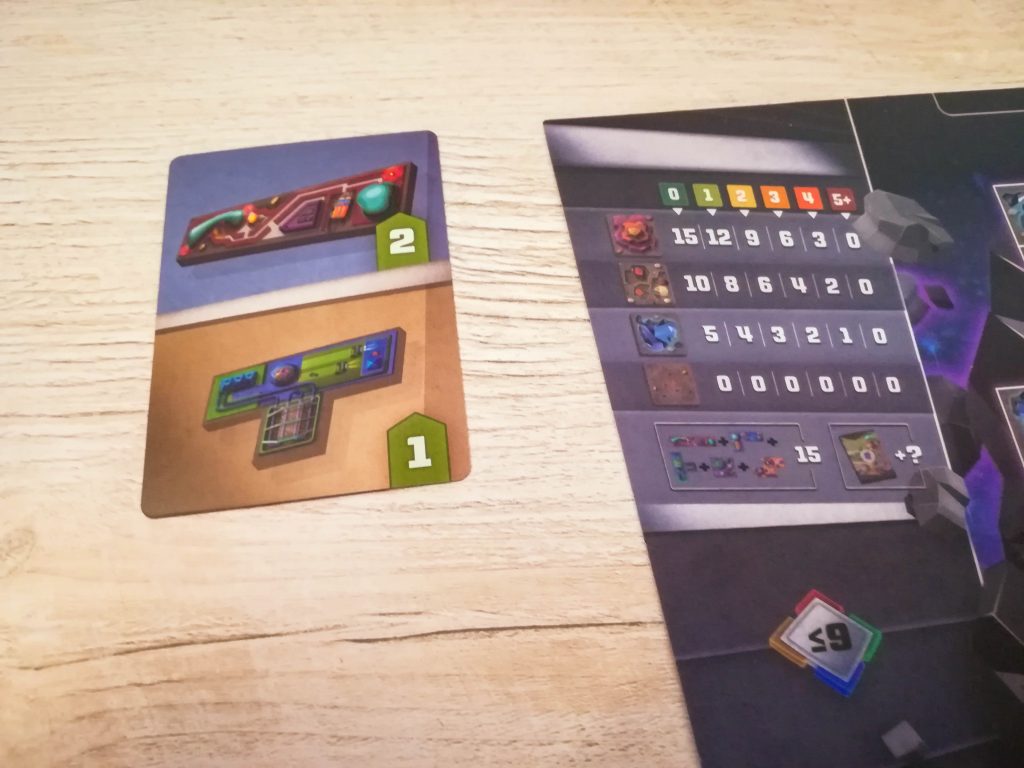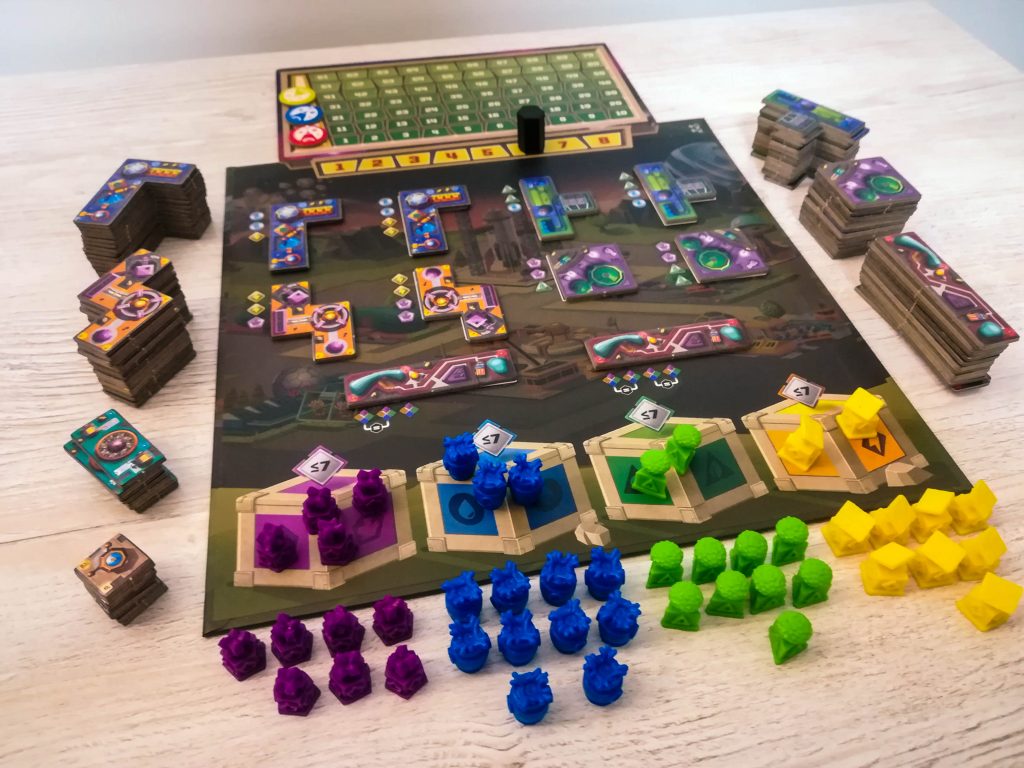Cosmic Colonies – Journal Entry #13

Cosmic Colonies is the second space-themed game that joins my collection, the other one being Tiny Epic Galaxies, both designed by the same person, Scott Almes. Popular for the Tiny Epic series, he is a very good designer whose games are loved by a lot of people!
It is a polyomino game that has players build space bases on asteroids by drafting tiles and cards while also managing resources. There’s plenty of variability in this game and I’ve had lots of fun playing it with my group.
How to play Cosmic Colonies
Inside the box you’ll find many components of various shapes and sizes: tiles, tokens, mats and cards. There are 96 Building Tiles of 7 types, shaped just like most tiles in polyomino games. There are 60 plastic Resource Tokens of 4 colors: purple, green, yellow and blue. There’s a Main Board and 6 player mats (Asteroid Boards). These are all double sided, based on the number of players or the difficulty you chose to play. There are two types of cards: Objective Cards and Worker Cards. The later ones are also varied based on difficulty or game mode: Basic, Advanced and Solo. There are also score and round markers, and a Score Track that has a 2-player board on its back.
The setup is fast and simple, and can be done in a couple of minutes. You place the Main Board in the center of the table with the appropiate side facing up, based on the number of players. Do not forget to place the Round Marker on the first space of the Round Track at the top of the board. If playing a 2-player game, flip the Score Track over to show the 2-player side. Otherwise, place it face-up and place each player’s Score Marker on the 0 space.

After that, you fill each Resource Location on the board with its matching Resource Tokens, adding 1 token per player at the table. You will place the remaining Resource Tokens near the board, forming the resources supply. Following up, you fill the Building Slots with their corresponding tiles (the 1×1 and 2×1 tiles will not be placed on the Main Board). You end up placing the remaining Building Tiles to the side of the board to form the buildings supply.
Decide which game mode you want to play (Basic or Advanced) and then give each player a random Asteroid Board, placing it with the corresponding face up. Take the corresponding deck of Worker Cards based on the game mode and deal 4 cards to each player, and then randomly deal an Objective Card to each player. The game can now begin!

The game plays over the course of 8 rounds, broken into 2 phases:
- Action Phase: Players select one Worker Card from their hand and then simultaneously reveal it. Each player chooses whether to collect resources or place a building on their asteroid. These actions are done in order of Worker Priority, from the smallest to the largest number. The players repeat these steps once more, choosing a second Worker Card and performing a second action.
- Refresh Phase: The Resource Location are refilled with 1 token per player. When refilling the Resource Location, you can not exceed the token limit based on the number of players. Building Slots are also refilled. The players pass the used cards clockwise. The Round Marker is moved on the Round Track and the next round can begin.
Worker cards have special abilities that can break some gameplay rules. Some of these can be played before taking an action, others can change the way an action is done. When collecting resources, a player selects one Resource Location on the Main Board and collects Resource Tokens from that location equal to their worker’s Carry Limit, if their card’s ability does not state otherwise. If there are too few tokens at that location, they collect all the available tokens at that location instead. A player’s Warehouse on their Asteroid Board can only hold 9 Resource Tokens at a time. If a player exceeds this limit, they must return tokens of their choice to the supply.

When placing a building, the player has to pay its cost in Resource Tokens, returning them to the supply. He then takes the corresponding Building Tile from the Main Board and place it on his Asteroid Board. A player can not choose a building if there are no tiles of that type available on the Main Board.
At the end of the 8th round, the scoring phase begins. Players earn 15 points per complete set of 5 Main Building Tiles placed on their asteroid. Each player will be awarded points based on the buildings on their Objective Card. They also earn points based on how much terrain they covered on their Asteroid Board, based on a scoring table. The player with the highest score wins!

The Advanced Mode adds a day-night cycle to the game. These cards contain two abilities instead of one, each one available during a certain time of the day. When a player plays his first card during a round, he uses the Day Ability of the card. When playing the second card, he will use the Night Ability of that card. The Dirt Terrain Tiles on the Asteroid Board now score 1 point each if uncovered. The players should now aim not to cover too much Dirt if they want to score more points.
There’s also a Solo mode version where you control a Robot as a second player. You choose the difficulty of this mode by placing a Score Marker on the Difficulty Track at the top of his Asteroid Board. This deck has two actions on the bottom of the card, available only for the Robot. Instead of having cards in his hand, the Robot reveals the top card of the Worker Deck and plays it. On his turn, he tries to complete the 1st action on that card. If he fails to do so, he then attempts to do the 2nd action. If that fails too, then his turn is over.

The Robot collect the building tiles on his Asteroid Board instead of placing them on a grid like players do. When scoring for the Robot, you multiply the number of tiles collected and the difficulty level and then substract 4 points for each tile type that he didn’t build at least one of. He also does not earn any point for collecting sets of building tiles. All other rules stay the same.
My thoughts about Cosmic Colonies
I like how this game comes with many variants to play it: Basic, Advanced, Two-player and Solo. This adds a lot of variety to the game, as you can literally play it at any player count from 1 to 5 and you can adjust the difficulty based on your group. That’s a big bonus on my list, as I have multiple groups I play with and I also enjoy playing games all by myself!
Personally, I think that the Advanced Mode is the way the game is meant to be played. The day-night cycle adds more decisions at play and it feels more complete. We’ve also had more fun playing it this way. The Basic Mode may be too light for us, but I think it’s good for teaching newbies how to play.

Solo Mode can be tough, as the Robot can score a lot of points quite easy, but I found that to be a good challenge. For you as a player, the game goes the same as during Two-Player game: you try to score as many points by covering your grid and completing your Objective Card. However, the Robot is a point hoarder. He earns points based on the difficulty level and on how many buildings he constructed. So if you set the difficulty level to 7 and he built 8 tiles on his mat, he scores 56 points! That’s a lot!
However, knowing that the Robot goes for the bottom-left action first and then if that fails, he goes for the 2nd one, you can sometimes plan you actions based on what Worker Card he plays and deny him some points. If his 1st action is Place a Building, I sometimes choose to buy that tile myself and place it on my grid just so he’ll have to go for the 2nd action (which I usually hope is Collect Resources).
Although scoring is really simple, I found it hard to actually score high. And that didn’t happen just for me, but many other in my group faced the same problem. None of us ever managed to actually cover the all the red terrain on the grid and earn 15 points out of it. we usually ended up with at least 2 or 3 of these still showing up. We also managed to cover the second type of terrain only once, so I’m not sure if this was meant to be hard, or we’re just bad at choosing our buildings.
We noticed that you usually earn the 15 points for a complete set of 5 Main Building Tiles on your asteroid only once during the game. The buildings get drafted fast and it’s quite hard to get the building that you are aiming for if you do not go first or second during a turn (usually by sacrificing better plays in favor of this). But again, maybe it’s because we may be bad at choosing our buildings.

The card drafting mechanism is really smart. Having to consider which cards you play knowing that the player to your left will get those cards to use on his next turn is very tough. You have to be smart and plan your cards based on how much they help you and on how much they’d help the next player, and that can sometimes hurt you. You can choose not to play a good card as it may help your opponent in the future and play a worse card instead, but I do not recommend that. After all, if the card is that good, it will keep getting drafted, and may come back to you again in the future, thus you may get the chance to play it again after a few turns.
Cosmic Colonies is my first polyomino game and I am glad that it is now part of my collection. It is fun to play, has a great combination of mechanics that can trigger interesting decisions during gameplay and the variability in it makes for an enjoyable game that can be played at any time! If you are new to polyomino games or you’ve never played one before, I recommend giving it a try!
Useful info
Designer: Scott Almes
Publisher: Floodgate Games
Players: 1-5
Time: 30-45 min
Times played: 11
Full disclosure: A copy of Cosmic Colonies was provided by the game publisher.
Did you like the review? Follow me on my Instagram page where I post daily photos of games I play and other things. You can also support me on Patreon to gain access to various special content, such as game unboxings, first impressions, polls to decide what games to cover next, and early access to reviews!


